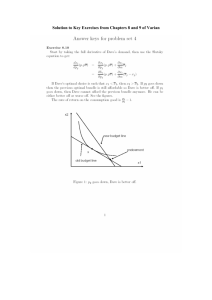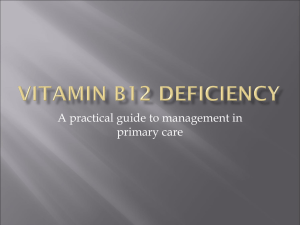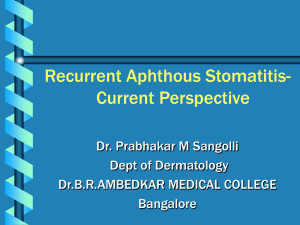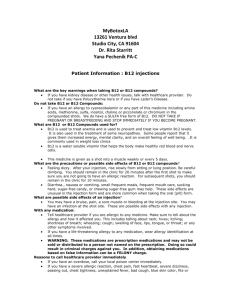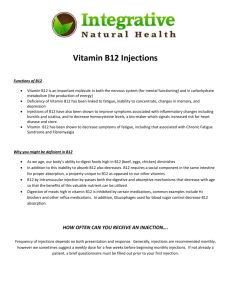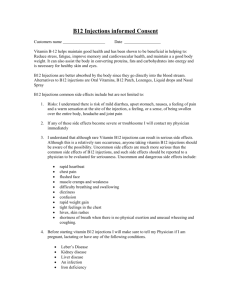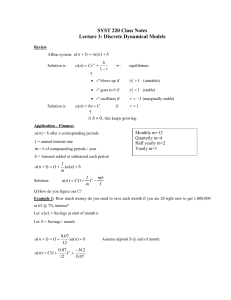Vitamin B12 Blake Whitlow Ruben Lopez III CHEM 489
advertisement
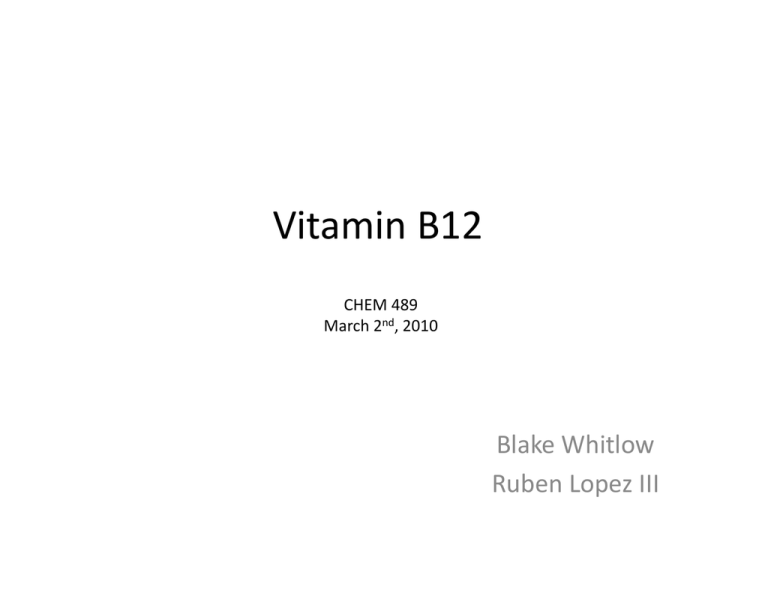
Vitamin B12 CHEM 489 March 2nd, 2010 Blake Whitlow Ruben Lopez III Linked Disease • Pernicious Anemia • Often seen in the elderly • Lack of the Intrinsic Factor in the stomach • Vegetarians, not true for lacto‐ovo vegetarians • The common symptom is fatigue History of B12 • Dr. Newcastle • Fed anemic patients his regurgitated gastric juices • Dr. Whipple • Bled dogs to induce anemia • Raw liver cured the fastest • Minot and Murphy • Confirmed that the key compound was within the liver tissue • Karl A. Folkers and Alexander R. Todd • Discovered, Isolated, and named cobalamine Structure of Cyanocobalamin B12 • Dr. Dorothy Crowfoot Hodgkin • 1950’s • X‐Ray Crystallography Functions of B12 • Involved in the metabolism of every cell of the body • DNA synthesis and regulation • Used to regenerate folate in the body •Most B12 deficient symptoms are actually folate deficient symptoms • Due to poor synthesis of DNA when the body does not have a good supply of folic acid for the creation of thymine Folic Acid Corrin vs. Porphyrin Corrin Ring Porphyrin Ring Corrin vs. Porphyrin • High number of sp3 carbon centers • More flexible • Not as flat as a porhpyrin ring • Relatively high rigidity and resistance to change in electronic structure • Two tautomeric forms Cobalamins Known Enzymatic Reactions 1,2 Shift Mechanism Coenzyme B12‐catalyzed reactions 2. Methyl (‐CH3) group transfers between two molecules • B denotes a neutral or anionic nucleophile • Homolytic Fission • Heterolytic Fission Coenzyme B12‐catalyzed reactions 1. Rearrangements in which a hydrogen atom is directly transferred between two adjacent atoms with concomitant exchange of the second substituent, X, which may be a carbon atom with substituent, an oxygen atom of an alcohol, or an amine. Coenzyme B12‐catalyzed reactions Homolytic Cleavage: •A reaction where a hydrogen and a group on an adjacent carbon atom exchange places. •Takes place by way of a radical mechanism. (i.e. Deoxyadenosyl Radical ) •These rearrangements are very rare in organic chemistry. Coenzyme B12‐catalyzed reactions Deoxyadenosyl Radical was Characterization: •Electron Paramagnetic resonance signals formed when diol dehydrase and five equivalents of coenzyme B12 were incubated. •Shows the generation and persistance of deoxyadenosyl radical. Coenzyme B12‐catalyzed reactions Mechanism of Cobalt‐Carbon Bonding: Step 1: substrate (1,2‐dihydroxyethane) approaches the holoenzyme, attempting to plug the reaction 'bottle'. Step 2: ‐cobalt‐carbon bond breaks homolyticallly. ‐is now weakened by binding of the metalloenzyme to the large coenzyme. Step 3: hydrogen atom taken from substrate by the 5'‐deoxyadenosyl radical creating a methyl. Coenzyme B12‐catalyzed reactions Mechanism of Cobalt‐Carbon Bonding: Step 4: enzyme base (B) and the acid (BH+) cause assisted beta‐hydroxy fragmentation. (i.e. loss of water molecule) Step 5: re‐addition of a water molecule, resulting in a substrate reorientation of C2 towards the 5'deoxyadenosyl methyl. Step 6: substrate dehydration and release of ethanal and a water molecule. Coenzyme B12‐catalyzed reactions Methionine synthase: Coenzyme B12‐catalyzed reactions 2. Methyl (‐CH3) group transfers between two molecules ‐Ability to suppress the protonation of cobalt I. ‐Ability to change the equilibrium constant for methyl transfer. Coenzyme B12‐catalyzed reactions Heterolytic Cleavage: • • • For Methyl transfer reactions involving CH3-B12, Co(I) is involved. Reaction catalysed by methionine synthase. This involves two methyl group transfers: Me-cob(III)alamin + homocysteine ---> cob(I)alamin + methionine cob(I)alamin + methyltetrahydrofolate ---> Me-cob(III)alamin + tetrahydrofolate Dietary Uptake of B12 • Intrinsic Factor • Haptocorrin • Transcobalamin II Dietary Uptake of B12 Dietary Uptake of B12 Dietary Uptake of B12 Dietary Uptake of B12 B12 as a Drug Transport Vehicle In order to take advantage of the pathway shown in slide 20: • Need to couple B12 with the peptide/protein such that neither molecule obstructs the other • Used to deliver therapeutic peptides • Potential to aid absorption from the gastrointestinal tract increase plasma‐residency time • Limited by the quantity of B12 that may be absorbed from the intestinal lumen with a given dose References: 1.) 2.) 3.) 4.) 5.) 6.) 7.) 8.) 9.) 10.) 11.) 12.) 13.) 14.) 15.) 16.) 17.) 18.) 19.) 20.) 21.) 22.) 23.) 24.) 25.) Lenhert , P.G.; Hodgkin, D.C. Nature 1961 192, 937 Lenhert, P.G. Proc.Roy.Soc. 1968 A303, 45 Mancia, F.; Keep, N.H.; Nakagawa, A.; Leadlay, P.F.; McSweeney, S.; Rasmussen, B.; Bosecke, P.; Diat , O.; Evans, P.R. Structure 1996, 4, 229 Briat, B.; Djerassi, C. Soc. Chim. France 1969 135 Johansen, H.; Ingraham, L. L.; J. Theor. Biol. 1969 23, 191 C. Brink, D. C. Hodgkins, J. Lindsey, J. Pickworth, J. H. Robertson, J. G. White, Nature 1954 174, 1169 J. M. Pratt, Inorganic Chemistry of Vitamin B12, Academic Press, London 1972 Gaudemer, A., Zylber, J., Zylber, N., Baran‐Maraszac, M., Hull, W. E., Fountoulakis, M., Konig, A., Wolfle, K., Retey, J. 1981 Eur. J. Biochem. 199, 279‐285 Leutherner, B., Leutwein, C., Shulz, H., Horth, P. Haehel, W., Schiltz, E., Schagger, H., Heilder, J. 1998, Mol. Microbiol. 28, 615‐628 Lu. W.‐P., Harder, S. R., Ragsdale, S. W. 1990, J. Biol. Chem. 265, 3124‐3133 Jarret, J. T. Choi, C. Y., Matthews, R. G. 1997, Biochemistry 1926, 15739‐15748 Rusling, J. F., Miaw, C.‐L., Couture, E. C. 1990, Inorg. Chem. 1929, 2025‐2027 B. Briat, C. Djerassi, Bull. Soc. Chim. France 1969 135 Jerrett, J. T., Choi, C. Y., Matthews, R. G. 1997, Biochemistry 36, 15739‐15748 Lexa, D., Saveant, Soufflet, J. P. 1979, J. Electroanal. Chem. 100, 159‐172 Schefford, R., Rytz, G., Walder, L. 1983, Modern Synthetic Methods. Transition Metals in Organic Synthesis pp. 335‐440 Rusling, J. F., Miaw, C.‐L., Couture, E. C. 1990, Inorganic. Chem. 29, 2025‐2027 Connors, T. F., Arena, j. V., Rusling, J. F. 1988, J. Phys. Chem. 92, 2810‐2816 Scheffold, R. 1988, Nachr. Chem. Tech. Lab. 1936, 261‐267 Auer, L., Weymuth, C., Scheffold, R. 1993, Helv. Chim. Acta. 1976, 810‐818 Busato, S., Tinembart, O., Zhang, Z.‐d., Scheffold, R. 1990, tetrahedron 46, 3155‐3166 Busato, S., Scheffold, R. 1994, Helv. Chim. Acta. 77, 92‐99 Steiger, B., Walder, L., Scheffold, R. 1986, Chimia 40, 93 Howard, W. A., Bayomi, A., Natarajan, E., Aziza, M. A., El‐Ahmady, O., Grissom, C. B., West, F. G. 1997, Bioconj. Chem. 8, 498‐502 Ramanujam, K. S., Seetharam, S., Seetharam, B. 1992, Biochem. Biophys. Res. Comm. 182, 439‐446
